Ancient Indian Agriculture
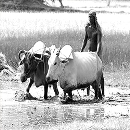 Manuring The excavation of the Mehrgarh period sites that is around 8000-6000 BC throws some startling facts about Indian agriculture that began as early as 9000 BC. The domestication of plants and animals are reported in the subcontinent by 9000 BC. Wheat, barley and jujube were among crops, sheep and goats were among animals that were domesticated. This period also saw the first domestication of the elephants.
Manuring The excavation of the Mehrgarh period sites that is around 8000-6000 BC throws some startling facts about Indian agriculture that began as early as 9000 BC. The domestication of plants and animals are reported in the subcontinent by 9000 BC. Wheat, barley and jujube were among crops, sheep and goats were among animals that were domesticated. This period also saw the first domestication of the elephants.
With implements and techniques being developed for agriculture settled life soon followed in India. Double monsoons that led to two harvests being reaped in one year in the country facilitated the settled mode of production.
In the Neolithic period roughly 8000-5000 BC, agriculture was far from the dominant mode of support for human societies, but those who adopted it flourished. Agro pastoralism in India included threshing, planting crops in rows—either of two or of six—and storing grain in granaries. They passed their techniques of agricultural production to the next generation. This transformation of knowledge was the base of further development of agriculture in India.
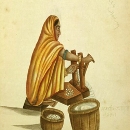
cotton spinning
Agricultural communities became widespread in Kashmir valley around 5000 BC. It was reported that Cotton was cultivated by 5000 – 4000 BC in Kashmir.
As early as 4530 BC and 5440 BC wild Oryza rice appeared in the Belan and Ganges valley regions of northern India. At that time hemp was also domesticated and its applications was in number of things including making narcotics, fibre and oil.
Ancient Indian Agriculture in Indus Valley Civilization
Indus Valley civilization relied on the considerable technological achievements of the pre-Harappan culture, including the plough. The farmers of the Indus Valley grew peas, sesame, and dates. Rice was cultivated in the Indus Valley Civilization.
Indus civilization people practiced rainfall harvesting. At a recently discovered Indus civilization site in western India, archaeologists discovered a series of massive reservoirs, hewn from solid rock and designed to collect rainfall, that would have been capable of meeting the city's needs during the dry season.
The Indus cotton industry was well developed and some methods used in cotton spinning and fabrication.
Agricultural activity during the second millennium BC included rice cultivation in the Kashmir and Harrappan regions are noticed. Mixed farming was the basis of the Indus valley economy.
Several wild cereals, including rice, grew in the Vindhyan Hills, and rice cultivation, at sites such as Chopani-Mando and Mahagara, was underway as early as 7000 BC. Chopani-Mando and Mahagara are located on the upper reaches of the Ganges drainage system.
Irrigation was developed in the Indus Valley Civilization by around 4500 BC. The size and prosperity of the Indus civilization grew as a result of this innovation. It eventually led to more planned settlements making use of drainage and sewers.
Sophisticated irrigation and water storage systems were developed by the Indus Valley Civilization, including artificial reservoirs at Girnar dated to 3000 BC, and an early canal irrigation system in 2600 BC.
Archaeological evidence of an animal-drawn plough dates back to 2500 BC. Some animalsthought to be vital for survival were worshiped. Trees were also domesticated and worshiped. Pipal and Banyan tree was venerated. Others tress that had their medicinal uses found mention in the holistic medical system Ayurveda.
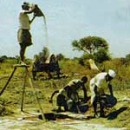
crop protection
Ancient Indian Agriculture in Vedic period
There are repeated references to iron in the later Vedic texts (BC. 1000–500 BC). Cultivation of a wide range of cereals, vegetables, and fruits is described in the text. Meat and milk products were part of the diet; animal husbandry was important. The soil was ploughed several times. The importance of seeds was emphasised and a certain sequence of cropping were recommended. Cow dung provided the manure and irrigation was practiced was during this time.
Ancient Indian Agriculture in Mauryan Empire
The Mauryan Empire (322–185 BCE) categorized soils and made meteorological observations for the agricultural use. Other Mauryan facilitation included construction and maintenance of dams and provision of horse-drawn chariots—that was quicker than traditional bullock carts.
The Greek diplomat Megasthenes (300 BC) in his book Indikaprovides an eyewitness account of Indian agriculture at that time.
He writers, “India has many huge mountains which abound in fruit-trees of every kind, and many vast plains of great fertility. The greater part of the soil is under irrigation, and consequently bears two crops in the course of the year.In addition to cereals, there grows millet, anddifferent sorts of pulse and rice throughout India. Since there are two monsoons in the course of each year the inhabitants gather in two harvests annually. “
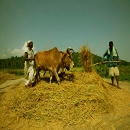
South Indian agriculture
Ancient South Indian Agriculture
The agriculture scene of South India was equally bright in Ancient India. The Tamil people cultivated a wide range of crops such as rice, sugarcane, millets, black pepper, various grains, coconuts, beans, cotton, plantain, tamarind and sandalwood, Jackfruit, coconut, palm, areca and plantain trees etc.
Systematic ploughing, manuring, weeding, irrigation and crop protection was practiced for sustained agriculture in South India.
Water storage systems were designed during this period. Kallanai (1st-2nd century AD), a dam built on river Kaveri, is considered the as one of the oldest water-regulation structures in the world that is still in use.
Agriculture Trade in Ancient India
Foreign crops were introduced to India and Indian products soon reached the world via existing trading networks. Spice trade involving spices such as cinnamon and black peppergained momentum and India started shippingthem to the Mediterranean.
The detailed archaeological record and the Periplus of the ErythraeanSea show that India’s trade with Roman Empire flourished. During the early centuries of the Common Era, Chinese sericulture attracted Indian sailors.
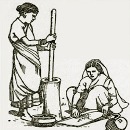
The agrarian societyThe earliest reference of candied sugar or crystallized sugar comes from the time of the Guptas (320-550 AD). Soon the traveling Buddhist monkstransmitted the process of making sugar to China. Chinese documents confirm at least two missions to India, initiated in 647 AD, for obtaining technology for sugar-refining.
Indian spice exports find mention in the works of IbnKhurdadhbeh (850), al-Ghafiqi (1150), Ishak bin Imaran (907) and Al Kalkashandi (fourteenth century).
Ancient Indian Agriculture in Chola Period
The agrarian society in South India during the Chola Empire (875-1279) reveals that collective holding of land slowly gave way to individual plots, each with their own irrigation system during Chola rule.
The Cholas also had bureaucrats which oversaw the distribution of water, particularly the distribution of water by tank-and-channel networks to the drier areas. The growth of individual disposition of farming may have led to a decrease in areas of dry cultivation.
Contribute More Facts